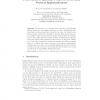285 search results - page 16 / 57 » Computationally Sound, Automated Proofs for Security Protoco... |
TARK
2007
Springer
14 years 1 months ago
2007
Springer
We introduce (i) a general class of security protocols with private channel as cryptographic primitive and (ii) a probabilistic epistemic logic to express properties of security pr...
JOC
2007
13 years 7 months ago
2007
Signcryption is a public key or asymmetric cryptographic method that provides simultaneously both message confidentiality and unforgeability at a lower computational and communica...
DCC
2008
IEEE
14 years 7 months ago
2008
IEEE
LaMacchia, Lauter and Mityagin recently presented a strong security definition for authenticated key agreement strengthening the well-known Canetti-Krawczyk definition. They also ...
CCS
2009
ACM
14 years 8 months ago
2009
ACM
Distributed proof construction protocols have been shown to be valuable for reasoning about authorization decisions in open distributed environments such as pervasive computing sp...
SP
1998
IEEE
13 years 11 months ago
1998
IEEE
A strand is a sequence of events; it represents either the execution of legitimate party in a security protocol or else a sequence of actions by a penetrator. A strand space is a ...


